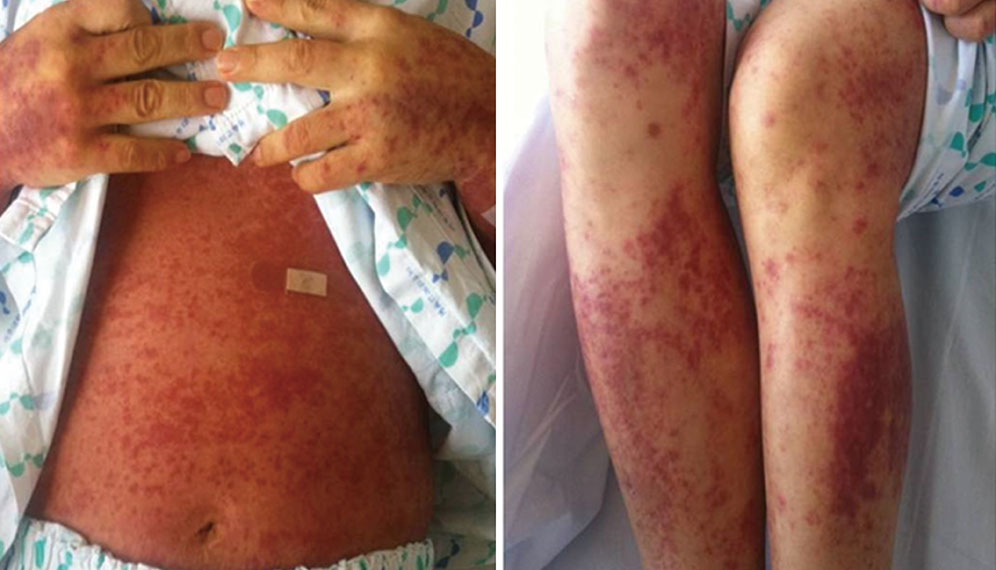Allergy Asthma Respir Dis.
2013 Sep;1(3):280-283. 10.4168/aard.2013.1.3.280.
T-cell lymphoma presenting as drug rash with eosinophilia and systemic symptoms syndrome
- Affiliations
-
- 1Department of Allergy and Clinical Immunology, Ajou University School of Medicine, Suwon, Korea. hspark@ajou.ac.kr
- KMID: 2262972
- DOI: http://doi.org/10.4168/aard.2013.1.3.280
Abstract
- Drug rash with eosinophilia and systemic symptoms (DRESS) syndrome is diagnosed by three criteria including cutaneous drug eruption, hematologic abnormalities, and systemic involvements. The hematologic abnormalities include presence of atypical lymphocytes or eosinophilia. The systemic involvements include lymphadenopathy, hepatitis, interstitial nephritis, interstitial pneumonia, or carditis. We experienced a 41-year-old female patient who presented DRESS syndrome at initial visit, but finally manifested with T-cell lymphoma. The patient complained of erythematous pruritic plaques with itching on her abdomen and thigh. There was no initiating factor and she was diagnosed with urticarial dermatitis. After treatment with antihistamine and systemic steroid, she recovered from skin lesion. However, 1 month later, she came to emergency department with aggravated skin lesion after taking nonsteroidal anti-inflammatory drug for 3 days. On admission, she showed a fever, skin rash, atypical lymphocytes in peripheral blood smear, and hepatitis. She was treated with systemic steroid under the impression of DRESS syndrome. Her symptoms began to improve, however, laboratory parameters were aggravated again. We performed bone-marrow biopsy because of her unusual progress. Finally she diagnosed with peripheral T-cell lymphoma and treated with allo-peripheral blood stem cell transplantation. In conclusion, we report a case of T-cell lymphoma which presented as DRESS syndrome. If patients with DRESS syndrome present lymphadenopathy and atypical lymphocytes, and do not respond to anti-inflammatory treatment, we should consider underlying lymphoproliferative disease.
Keyword
MeSH Terms
-
Abdomen
Adult
Biopsy
Dermatitis
Drug Eruptions
Emergencies
Eosinophilia
Exanthema
Female
Fever
Hepatitis
Humans
Lung Diseases, Interstitial
Lymphatic Diseases
Lymphocytes
Lymphoma
Lymphoma, T-Cell
Lymphoma, T-Cell, Peripheral
Myocarditis
Nephritis, Interstitial
Porphyrins
Pruritus
Skin
Stem Cell Transplantation
T-Lymphocytes
Thigh
Porphyrins
Figure
Reference
-
1. Bigby M, Jick S, Jick H, Arndt K. Drug-induced cutaneous reactions: a report from the Boston Collaborative Drug Surveillance Program on 15,438 consecutive inpatients, 1975 to 1982. JAMA. 1986; 256:3358–3363.
Article2. Turk BG, Gunaydin A, Ertam I, Ozturk G. Adverse cutaneous drug reactions among hospitalized patients: five year surveillance. Cutan Ocul Toxicol. 2013; 32:41–45.
Article3. Roujeau JC, Stern RS. Severe adverse cutaneous reactions to drugs. N Engl J Med. 1994; 331:1272–1285.
Article4. Roujeau JC. Clinical heterogeneity of drug hypersensitivity. Toxicology. 2005; 209:123–129.
Article5. An SY, Hwang EK, Kim JH, Kim JE, Jin HJ, Jin SM, et al. Vancomycin-associated spontaneous cutaneous adverse drug reactions. Allergy Asthma Immunol Res. 2011; 3:194–198.
Article6. Bocquet H, Bagot M, Roujeau JC. Drug-induced pseudolymphoma and drug hypersensitivity syndrome (Drug Rash with Eosinophilia and Systemic Symptoms: DRESS). Semin Cutan Med Surg. 1996; 15:250–257.
Article7. Saltzstein SL, Ackerman LV. Lymphadenopathy induced by anticonvulsant drugs and mimicking clinically pathologically malignant lymphomas. Cancer. 1959; 12:164–182.
Article8. Rim MY, Hong J, Yo I, Park H, Chung DH, Ahn JY, et al. Cervical lymphadenopathy mimicking angioimmunoblastic T-cell lymphoma after dapsone-induced hypersensitivity syndrome. Korean J Pathol. 2012; 46:606–610.
Article9. Cacoub P, Musette P, Descamps V, Meyer O, Speirs C, Finzi L, et al. The DRESS syndrome: a literature review. Am J Med. 2011; 124:588–597.
Article10. Kano Y, Shiohara T. The variable clinical picture of drug-induced hypersensitivity syndrome/drug rash with eosinophilia and systemic symptoms in relation to the eliciting drug. Immunol Allergy Clin North Am. 2009; 29:481–501.
Article11. Jeung YJ, Lee JY, Oh MJ, Choi DC, Lee BJ. Comparison of the causes and clinical features of drug rash with eosinophilia and systemic symptoms and stevens-johnson syndrome. Allergy Asthma Immunol Res. 2010; 2:123–126.
Article12. Chan JK, Kwong YL. Common misdiagnoses in lymphomas and avoidance strategies. Lancet Oncol. 2010; 11:579–588.
Article13. Ogawa K, Morito H, Hasegawa A, Daikoku N, Miyagawa F, Okazaki A, et al. Identification of thymus and activation-regulated chemokine (TARC/CCL17) as a potential marker for early indication of disease and prediction of disease activity in drug-induced hypersensitivity syndrome (DIHS)/drug rash with eosinophilia and systemic symptoms (DRESS). J Dermatol Sci. 2013; 69:38–43.
Article
- Full Text Links
- Actions
-
Cited
- CITED
-
- Close
- Share
- Similar articles
-
- Rasagiline Induced Drug Rash with Eosinophilia and Systemic Symptoms Syndrome: A Case Report
- Drug Rash With Eosinophilia and Systemic Symptoms Syndrome Induced by Chloral Hydrate in Early Childhood
- Eosinophilic Polymyositis and DRESS (Drug Rash with Eosinophilia and Systemic Symptoms) Syndrome by Antitubercular Agents
- Dapsone-induced drug reaction with eosinophilia and systemic symptoms syndrome, misdiagnosed as lymphoma
- A Case of Drug Rash with Eosinophilia and Systemic Symptoms Associated with Valproic Acid and Olanzapine Treatment in Patient with Bipolar Disorder



